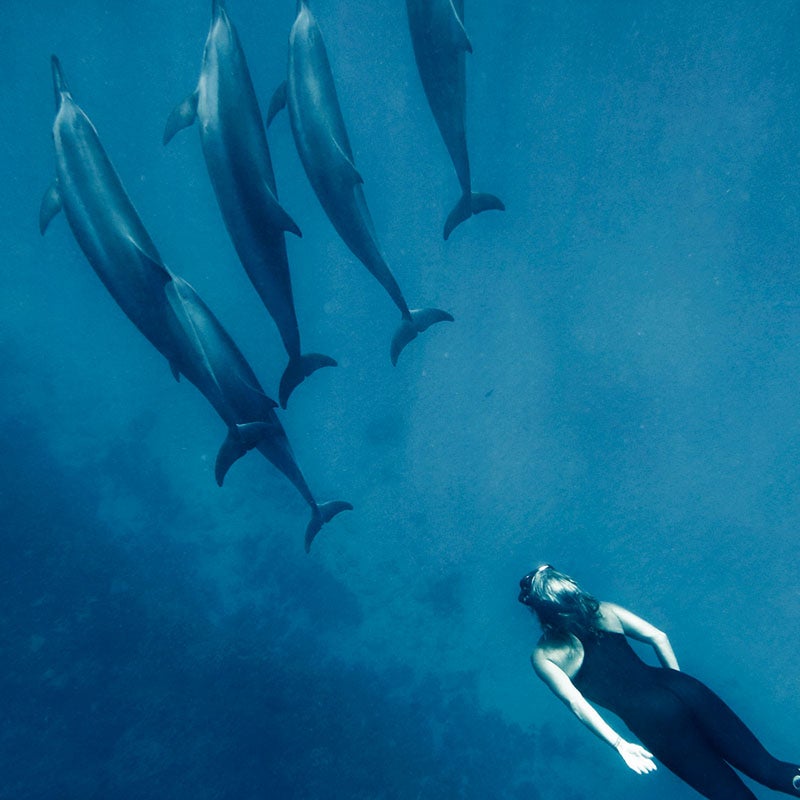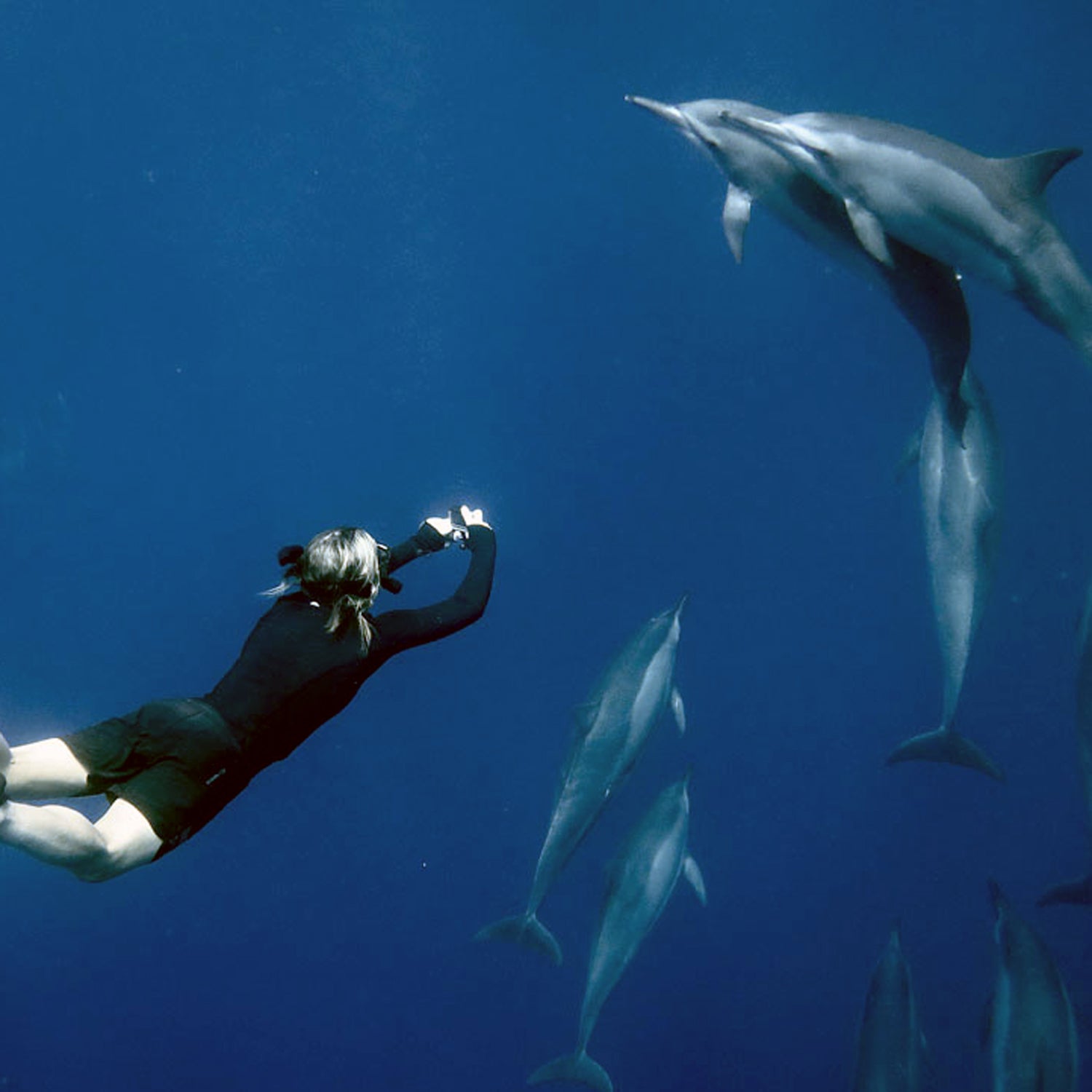Five years ago, while swimming in Honolua Bay off the northwest coast of Maui, writer Susan Casey had what she considers a supernatural interaction with a pod of about 50 spinner dolphins. The animals swirled around her, leaping, playing, diving, and effectively coaxed Casey out of a two-year-long period of mourning over the death of her father. That event jarred something loose in Casey and inspired her latest non-fiction book, , due out August 4.
ŌĆ£They materialized like ghosts, shimmering in the ether,ŌĆØ Casey writes in Voices in the Ocean. As if sensing her sadness, one of the largest spinners, an eight-foot-long male with banded black eyes, looked at her in a way that Casey describes as ŌĆ£a profound, cross-species greeting.ŌĆØ
In the hands of a different writer, this moment might have come off as a hackneyed foray into yet another glamorized depiction of our favorite sea mammals. But Casey, author of the New York Times bestsellers , , and former editor-in-chief of O, The Oprah Magazine, quickly eviscerates that premise, launching into a meticulously reported global odyssey during which she sets out to answer the simple question: why do dolphins elicit such intense emotions and behaviors in humans?┬Ā
After five years of researching that question, Casey has the beginnings of an answer. ŌĆ£Wherever you find dolphins, you find extreme human behavior, both bright lights and dark shadows,ŌĆØ she says from her home on Maui.┬Ā
To explore this dichotomy Casey swims alongside cetaceans off the coast of the Big Island with members of a community known as ŌĆ£Dolphinville,ŌĆØ partakes in protests that turn ugly in the infamous town of Taiji, Japan, visits┬Āthe site of a mass dolphin slaughter in the Solomon Islands, and tours captive dolphin sites in the Dominican Republic and Canada. She also pores over tomes of dolphin (aka toothed whale) research, interviews the worldŌĆÖs leading cetacean scientists and, quite literally, dives into ancient Greek history off the coast of Santorini. ┬Ā

Fans of CaseyŌĆÖs writing know that she has an inexhaustible curiosity and a knack for fully embracing her subject. Reading The Wave felt like the page-turning equivalent of surfing a monster face. So it only makes sense that Casey wanted Voices in the Ocean to feel like what she describes as a ŌĆ£fascinating, kaleidoscopic, magic carpet tour through the universe of dolphins.ŌĆØ
But as anyone who has seen The Cove or Blackfish knows, itŌĆÖs not always a shiny, happy, rainbow-hued universe. Casey takes us to its darkest places, like the Solomon Islands, where, in 2013, villagers on a remote island killed nearly 1,000 dolphins in a single day. CaseyŌĆÖs reporting, which she conducted while living in Manhattan and heading up OprahŌĆÖs print empire, required her to undertake some sketchy adventures, like riding for hours in the South Pacific in a 12-foot-long steel rowboat with no radio, no GPS, no shade, and no lifejackets during a raging squall.┬Ā
ŌĆ£I have this weird thing when IŌĆÖm reporting, where I just donŌĆÖt care if IŌĆÖm in danger,ŌĆØ Casey says. ŌĆ£ItŌĆÖs like IŌĆÖm a different person and IŌĆÖll go anywhere and do anything to get the story.ŌĆØ WeŌĆÖre never quite sure where CaseyŌĆÖs investigation will take us nextŌĆöit could be to a sad waterpark in Niagara Falls where captive dolphins listlessly bob, or to the Utah desert where the worldŌĆÖs foremost dolphin-brain expert, , happens to reside in the countryŌĆÖs largest no-kill animal sanctuary.┬Ā
Casey isnŌĆÖt afraid to disseminate the uncomfortable realities about dolphin captivity, slaughter, and contamination, sometimes crossing the line from objective journalism to advocacy. And while she had no intention of writing an academic treatise, Casey isnŌĆÖt afraid to delve into the complex 55 million-year-old evolution of the cetacean brain.
ŌĆ£That was the biggest challenge of the book,ŌĆØ Casey says. ŌĆ£ThereŌĆÖs so much intriguing science and I had to distill it into the equivalent of a shot glass.ŌĆØ
Yet the selected science goes a long way in unraveling the mystery Casey set out to solveŌĆöwhy we feel a profound connection to this species. Who knew that dolphin brains have the capacity to understand the concept of a communal self? These types of evolutions allow Casey to maintain a hopeful tone throughout the book, always returning to her premise that once we stop destroying them, these brainy creatures have much to teach us.
ŌĆ£What I hope we will do is take all this knowledge and put it into a wisdom framework,ŌĆØ says Casey. ŌĆ£ThatŌĆÖs my challenge to everybody: WhatŌĆÖs our evolution? Can we take the things weŌĆÖve learned and do the right thing? ThatŌĆÖs where the hope comes in.ŌĆØ


